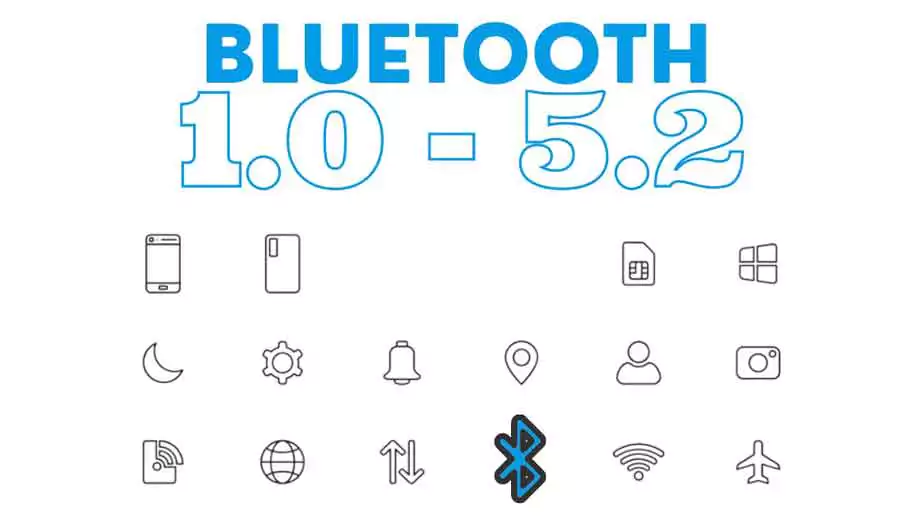The Bluetooth Version List Guide For Everyone

Bluetooth technology has come a long way since its inception in 1994. It has revolutionised how we communicate and enabled wireless connectivity between devices. As a result, Bluetooth has become an essential part of our daily lives and is used in various devices, including smartphones, tablets, laptops, headphones, and smartwatches.
Bluetooth devices have undergone several advancements over the years, with the introduction of new Bluetooth versions that offer enhanced features, increased data transfer rates, and lower power consumption. In this blog, we will discuss the different Bluetooth versions and their features.
1 What is Bluetooth Technology?
Bluetooth is a wireless communication protocol that enables communication between different devices. It is a short-range wireless technology that uses radio waves to transmit data between two devices. Bluetooth technology was created to provide a simple and cost-effective way of wirelessly connecting devices. It is now widely used in various gadgets and devices, including smartphones, wireless headphones, and other portable devices.
Bluetooth technology allows devices to communicate wirelessly with each other within a range of approximately 10 meters. The range can be extended to up to 100 meters with the use of Bluetooth amplifiers. Bluetooth technology has evolved significantly over the years, with new versions being introduced with more advanced features and capabilities.
2 Bluetooth Versions List
Bluetooth 1.0 and 1.0B
The first version of Bluetooth was released in 1999. It supported data transfer speeds of up to 1 Mbps and had a range of about 10 meters. It used frequency-hopping spread spectrum (FHSS) for transmission, which is a technique that divides the frequency band into smaller sub-bands and hops between them rapidly. Bluetooth 1.0 was not very popular due to its limited data transfer speeds and range. However, it laid the foundation for future Bluetooth versions.
Bluetooth 1.1
Bluetooth 1.1 was released in 2001 and offered a few improvements over Bluetooth 1.0. The major improvement was the addition of a secure, simple pairing (SSP) feature that made it more difficult for attackers to eavesdrop on Bluetooth connections. It also added support for multiple devices and improved the transmission power.
Bluetooth 1.2
Bluetooth 1.2 was released in 2003 and introduced a few key features that improved the performance of Bluetooth devices. The major improvement was the addition of an enhanced data rate (EDR) that improved the theoretical data transfer speeds up to 3 Mbps. It also introduced adaptive frequency hopping (AFH), which is a technique that reduces interference by dynamically changing the frequency hopping pattern. In addition, Bluetooth 1.2 also introduced extended synchronous connections (eSCO), which enabled wireless headsets to support better audio quality.
Bluetooth 2.0
Bluetooth 2.0 was released in 2004 and introduced several key improvements over Bluetooth 1.2. The major improvement was the addition of the host controller interface (HCI), which made it easier for manufacturers to develop Bluetooth-enabled devices. It also introduced the enhanced attribute protocol (EATT), which enabled faster data transfer speeds and lower power consumption. Bluetooth 2.0 also introduced the ability to connect to multiple devices simultaneously.
Bluetooth 2.1
Bluetooth 2.1 was released in 2007 and introduced several key features that improved the security and ease of use of Bluetooth devices. The major improvement was the addition of secure, simple pairing (SSP), which made it even more difficult for attackers to eavesdrop on Bluetooth connections. It also introduced the ability to connect to fixed and mobile devices, which made it possible to connect to devices such as printers and cameras.
Bluetooth 3.0
Bluetooth 3.0 was released in 2009 and introduced several key features that improved the data transfer speeds and power consumption of Bluetooth devices. The major improvement was the addition of high-speed data transfer (HS), which improved the theoretical data transfer speeds up to 24 Mbps. It also introduced the ability to use the internet protocol support profile (IPSP), which enabled Bluetooth devices to connect to the internet. In addition, Bluetooth 3.0 also introduced the ability to transfer large data packets, which improved the bulk data exchange rates.
Bluetooth 4.0
Bluetooth 4.0 was released in 2010 and introduced several key features that improved the power consumption and range of Bluetooth devices. The major improvement was the addition of Bluetooth low energy (BLE), which reduced the power consumption of Bluetooth devices by up to 90%. It also introduced the ability to connect to lower-power devices, such as sensors and fitness trackers. Bluetooth 4.0 also introduced the ability to use the attribute protocol (ATT), which enabled Bluetooth devices to exchange small amounts of data quickly.
Bluetooth 4.1
Bluetooth 4.1 was released in 2013 and introduced several key features that improved the reliability and ease of use of Bluetooth devices. The major improvement was the addition of the device discovery protocol (DDP), which made it easier for Bluetooth devices to discover and connect to each other. It also introduced the ability to connect to dual audio devices, which enabled users to listen to audio on two Bluetooth devices simultaneously. Bluetooth 4.1 also introduced the ability to use the slot availability mask (SAM), which improved the coexistence of Bluetooth and Wi-Fi signals.
Bluetooth 4.2
Bluetooth 4.2 was released in 2014 and introduced several key features that improved the security and data transfer speeds of Bluetooth devices. The major improvement was the addition of the le secure connections (LESC) feature, which made it even more difficult for attackers to eavesdrop on Bluetooth connections. It also introduced the ability to use the le data packet length extension (DLE), which improved the maximum data transfer rate by up to 2.5 times. Bluetooth 4.2 also introduced the ability to use the le power control (LPC) feature, which improved the power consumption of Bluetooth devices.
Bluetooth 5.0
Bluetooth 5.0 was released in 2016 and introduced several key features that improved the range, data transfer speeds, and power consumption of Bluetooth devices. The major improvement was the addition of the extended advertising feature, which enabled Bluetooth devices to broadcast data over a longer range. It also introduced the ability to use the enhanced power control (EPC) feature, which improved the power consumption of Bluetooth devices by up to 2.5 times. Bluetooth 5.0 also introduced the ability to use the le audio feature, which enabled high-quality audio streaming on Bluetooth devices.
Bluetooth 5.1
Bluetooth 5.1 was released in 2019 and introduced several key features that improved the accuracy and range of Bluetooth devices. The major improvement was the addition of the direction-finding feature, which enabled Bluetooth devices to determine the direction of other Bluetooth devices. It also introduced the ability to use the le mesh feature, which enabled Bluetooth devices to form mesh networks for better coverage and reliability.
Bluetooth 5.2
Bluetooth 5.2 was released in 2020 and introduced several key features that improved the security and ease of use of Bluetooth devices. The major improvement was the addition of the le ISO feature, which enabled Bluetooth devices to use a secure and reliable connection for industrial applications. It also introduced the ability to use the le power control (LPC) feature for wireless headphones, which improved the power consumption and audio quality.
3 Wrapping Up
In conclusion, Bluetooth technology has come a long way since its inception in 1994. It has become an essential part of our daily lives and is used in a variety of devices. Bluetooth versions have undergone several advancements over the years, offering enhanced features, increased data transfer rates, and lower power consumption.
From the early versions like Bluetooth 1.0 to the latest version like Bluetooth 5.2, each version has brought significant improvements in terms of security, data transfer rates, and power consumption. The latest versions, like Bluetooth 5.2, have introduced new features like LE audio, improved audio quality, and multi-antenna technology, making Bluetooth technology even more reliable and efficient. With Bluetooth technology constantly evolving, it will be interesting to see what new features the future versions will bring.
Community Q&A
About This Article
This article has been viewed 694 times.



